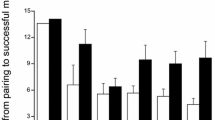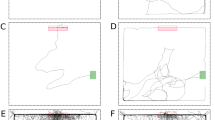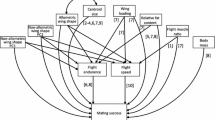Abstract
Male field crickets (Gryllus texensis) that differ in flight ability incur a life history trade-off between flight ability and reproduction, where flight ability comes with a male fitness cost. In courtship trials, flight-capable males produced courtship song, a necessary signal for mating success, with a significantly lower probability than flight-incapable males. The trade-off was evident in young males, and a similar trend occurred in older males. Males that lost the ability to fly through histolysis of flight muscles produced courtship song with a similar probability as males incapable of flight for their entire lives. Time of day did not affect the expression of the trade-off. Neither male morph nor time of day influenced female mating behavior.




Similar content being viewed by others
References
Balakrishnan R, Pollack GS (1996) Recognition of courtship song in the field cricket, Teleogryllus oceanicus. Anim Behav 51:353–366
Burk T (1983) Male aggression and female choice in field crickets (Teleogryllus oceanicus): the importance of courtship song. In: Gwynne DT, Morris GK (eds) Orthopteran mating systems: sexual competition in a diverse group of insects. Westview, Boulder, Colorado, pp 97–119
Cade WH (1979a) The evolution of alternative male reproductive strategies in field crickets. In: Blum MS, Blum NA (eds) Sexual selection and reproductive competition in insects. Academic, New York, pp 343–379
Cade WH (1979b) Field cricket dispersal flights measured by crickets landing at lights. Tex J Sci 31:125–130
Cade WH, Wyatt DR (1984) Factors affecting calling behaviour in field crickets, Teleogryllus and Gryllus (age, weight, density, and parasites). Behaviour 88:61–75
Crnokrak P, Roff DA (1995) Fitness differences associated with calling behaviour in the two wing morphs of male sand crickets, Gryllus firmus. Anim Behav 50:1475–1481
Crnokrak P, Roff DA (1998a) The contingency of fitness: an analysis of food restriction on the macroptery-reproduction trade-off in crickets. Anim Behav 56:433–441
Crnokrak P, Roff DA (1998b) The genetic basis of the trade-off between calling and wing morph in males of the cricket Gryllus firmus. Evolution 52:1111–1118
Crnokrak P, Roff DA (2000) The trade-off to macroptery in the cricket Gryllus firmus: a path analysis in males. J Evol Biol 13:396–408
Crnokrak P, Roff DA (2002) Trade-offs to flight capability in Gryllus firmus: the influence of whole organism respiration rate on fitness. J Evol Biol 15:388–398
Dingle H, Drake VA (2007) What is migration? Bioscience 57:113–121
Engelmann F (1970) The physiology of insect reproduction. Pergamon Press, New York
Fitzpatrick MJ, Gray DA (2001) Divergence between the courtship songs of the field crickets Gryllus texensis and Gryllus rubens (Orthoptera, Gryllidae). Ethology 107:1075–1085
Hack MA (1998) The energetics of male mating strategies in field crickets (Orthoptera: Gryllinae: Gryllidae). J Insect Behav 11:853–867
Harrison RG (1980) Dispersal polymorphisms in insects. Ann Rev Ecolog Syst 11:95–118
Holtmeier CL, Zera AJ (1993) Differential mating success of male wing morphs of the cricket, Gryllus rubens. Am Midl Nat 129:223–233
Hoy RR (1992) The evolution of hearing in insects as an adaptation to predation from bats. In: Webster DB, Fay RR, Popper AN (eds) The evolutionary biology of hearing. Springer, New York, pp 115–129
Johnson B (1954) Effect of flight on behaviour of Aphis fabae Scop. Nature 173:831–832
Murray A-M, Cade WH (1995) Differences in age structure among field cricket populations (Orthoptera; Gryllidae): possible influence of a sex-biased parasitoid. Can J Zool 73:1207–1213
Nelson CM, Nolen TG (1997) Courtship song, male agonistic encounters, and female mate choice in the house cricket, Acheta domesticus (Orthoptera, Gryllidae). J Insect Behav 10:557–570
Prestwich KN (1994) The energetics of acoustic signaling in anurans and insects. Am Zool 34:625–643
Rankin MA (1980) Effects of precocene I and II on flight behavior in Oncopeltus fasciatus, the migratory milkweed bug. J Insect Physiol 26:67–74
Roff DA (1986) The evolution of wing dimorphism in insects. Evolution 40:1009–1020
Roff DA (1994) Habitat persistence and the evolution of wing dimorphism in insects. Am Nat 144:772–798
Roff DA, Fairbairn DJ (1991) Wing dimorphisms and the evolution of migratory polymorphisms among the Insecta. Am Zool 31:243–251
Roff DA, Fairbairn DJ (1993) The evolution of alternate morphologies: fitness and wing morphology in male sand crickets. Evolution 47:1572–1584
Sakaluk SK (1997) Cryptic female choice predicated on wing dimorphism in decorated crickets. Behav Ecol 8:326–331
Souroukis K, Cade WH, Rowell G (1992) Factors that possibly influence variation in the calling song of field crickets—temperature, time, and male size, age, and wing morphology. Can J Zool 70:950–955
Wagner WE (2005) Male field crickets that provide reproductive benefits to females incur higher costs. Ecol Entomol 30:350–357
Zera AJ (2005) Intermediary metabolism and life history trade-offs: lipid metabolism in lines of the wing-polymorphic cricket, Gryllus firmus, selected for flight capability vs. early age reproduction. Integr Comp Biol 45:511–524
Zera AJ, Cisper G (2001) Genetic and diurnal variation in the juvenile hormone titer in a wing-polymorphic cricket: implications for the evolution of life histories and dispersal. Physiol Biochem Zool 74:293–306
Zera AJ, Denno RF (1997) Physiology and ecology of dispersal polymorphism in insects. Annu Rev Entomol 42:207–231
Zera AJ, Harshman LG (2001) The physiology of life-history trade-offs in animals. Ann Rev Ecolog Syst 32:95–126
Zera AJ, Rankin MA (1989) Wing dimorphism in Gryllus rubens: genetic basis of morph determination and fertility differences between morphs. Oecologia 80:249–255
Zera AJ, Sall J, Grudzinski K (1997) Flight_muscle polymorphism in the cricket Gryllus firmus: muscle characteristics and their influence on the evolution of flightlessness. Physiol Zool 70:519–529
Zhao Z, Zera AJ (2004a) The hemolymph JH titer exhibits a large-amplitude, morph-dependent, diurnal cycle in the wing-polymorphic cricket, Gryllus firmus. J Insect Physiol 50:93–102
Zhao Z, Zera AJ (2004b) A morph-specific daily cycle in the rate of JH biosynthesis underlies a morph-specific daily cycle in the hemolymph JH titer in a wing-polymorphic cricket. J Insect Physiol 50:965–973
Acknowledgements
We thank Michelle C. Dumoulin, Patrick Sabourin, and Rémi Narbonne for their assistance in the interpretation of the results from this experiment. We also thank Brian McGill for his assistance with our statistical analyses, and Ronald Chase for the use of facilities. We greatly appreciate the contributions of Michelle C. Dumoulin, Rémi Narbonne, Genevieve F. C. Nesbitt, and Ruben P. Martins towards animal care. Funding was provided by NSERC PGS-D and CGS-D2 scholarships to P.A.G. and by an NSERC Discovery Grant to G.S.P.
Author information
Authors and Affiliations
Corresponding author
Rights and permissions
About this article
Cite this article
Guerra, P.A., Pollack, G.S. A Life History Trade-Off Between Flight Ability and Reproductive Behavior in Male Field Crickets (Gryllus texensis). J Insect Behav 20, 377–387 (2007). https://doi.org/10.1007/s10905-007-9084-1
Published:
Issue Date:
DOI: https://doi.org/10.1007/s10905-007-9084-1




